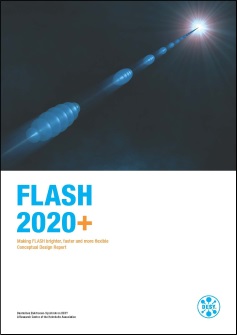URL: https://flash.desy.de/flash_upgrades/@@siteview
Breadcrumb Navigation
FLASH Upgrades
Within the FLASH strategy, the upgrade program FLASH2020+ will provide ambitious developments for the two FEL lines and the FLASH accelerator which are based on independent operation of the two FEL lines (FLASH1 and FLASH2). Both will be equipped with fully tunable variable-gap undulators and will be able to deliver photon pulses with variable polarization. Tunable undulators at FLASH1 will allow fully parallel operation of the two FEL lines. Up to now this is limited by the fact that the wavelength requested for experiments at FLASH1 determines the beam energy of the linear accelerator. At the same time, this upgrade will increase the available time for user experiments by almost 50%. Furthermore, with the new undulator configuration it will be possible to operate the accelerator at typically only two to three working points in terms of beam energy which will significantly reduce tuning time overhead and increase stability, again increasing the attractiveness and amount of beam time for users.
In addition to these improvements which are based on advancement of the current working conditions, within the FLASH2020+ project new qualities will be added to the XUV and soft X-ray photon beams that are strongly requested by the user community and will bring FLASH again into a leading position to explore new science with FELs: One of the two FEL lines shall be fully externally seeded with the full repetition rate that FLASH can provide in burst mode. The other line will exploit novel lasing concepts based on variable undulator configurations. Together with a small increase in electron beam energy to 1.35 GeV this will extend the wavelength reach of the fundamental harmonics to the oxygen K-edge, in order to cover the important elemental resonances for energy research and the entire water window for biological questions.
It includes a new experimental Hall "Kai Siegbahn" to double the number of user stations and an additional variable-gap undulator in a separate tunnel. Now two experiments can be served with FEL radiation at the same time. A unique featre is, that FLASH is able to deliver two largely independent wavelengths and pulse durations to two different user stations simultaneously with the full repetition rate of 10 Hz. The electron pulse train is shared between the present fixed-gap undulator line of FLASH1 and the new variable gap undulator FLASH2.
The major FLASH upgrade in 2009 included:
New accelerating modules (ACC1 & ACC7)
New third harmonic cavities, 3.9 GHz (ACC39)
Upgraded and new RF stations (2, 3 & 6)
Upgraded waveguide distribution
New RF Gun
Installtion of the seeding Experiment sFLASH
move LOLA downstream in fornt of SASE undulators
The major upgrade of FLASH in 2007 included:
Exchange of module 3* (ACC3) by module 7
Repair of module 5 (ACC5)
Installation of a new module 6 (ACC6)
New magnet power supplies
Change and redesign of the RF gun diagnostic section
New BPMs incl. BC3
New synchrotron radiation beamline (BC3)
New phase monitors
Optical replica device
New OTR+WS stations
Modification dogleg vacuum chamber
Fast orbit feedback system
New MCP detectors for more efficient photon energy detection
A new Infrared/THz undulator downstream the SASE undulators
Infrared/THz beamline to the experimental hall






 FLASH2020+ Conceptual Design Report
FLASH2020+ Conceptual Design Report
